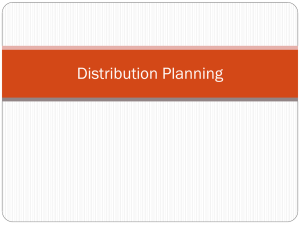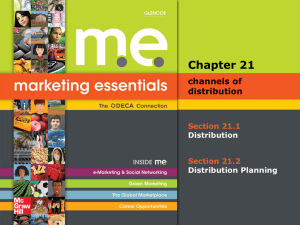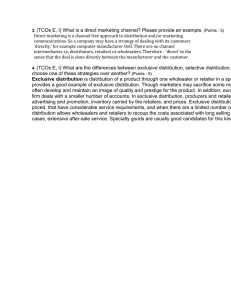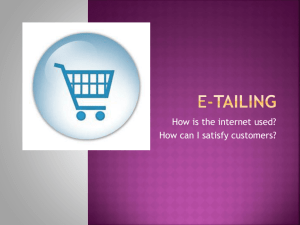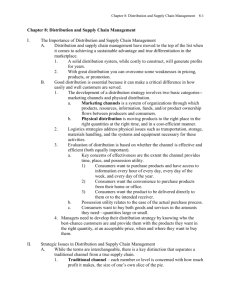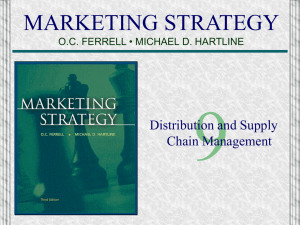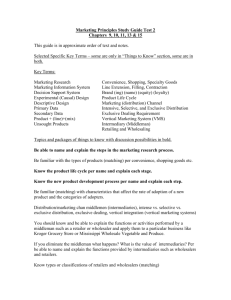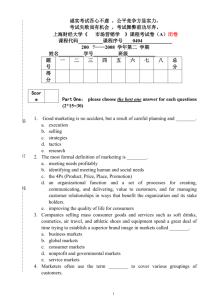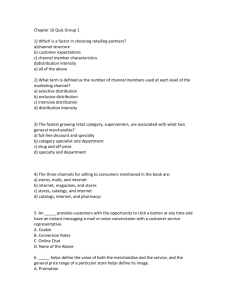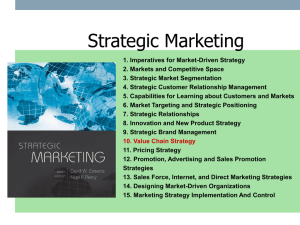Chapter 21 Section 21.2
advertisement
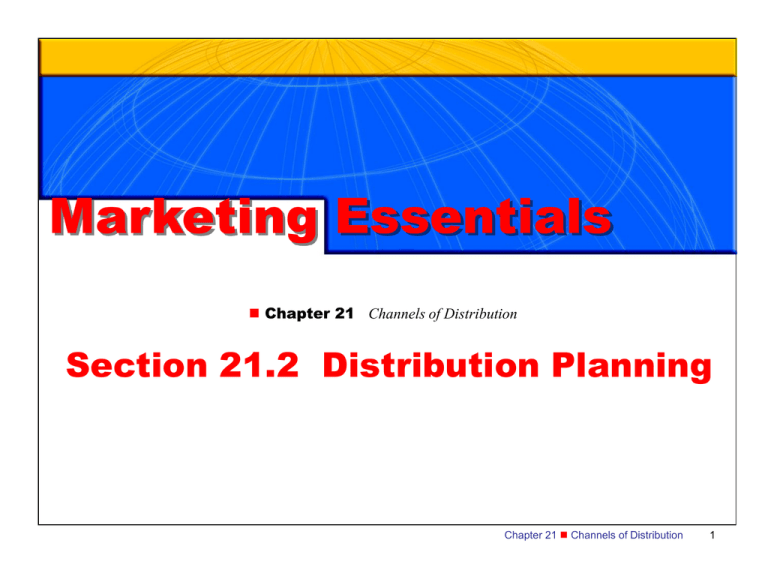
Marketing Essentials n Chapter 21 Channels of Distribution Section 21.2 Distribution Planning Chapter 21 n Channels of Distribution 1 SECTION 21.2 Distribution Planning What You'll Learn The key considerations in distribution planning When to use multiple channels of distribution How to compare the costs and control involved in having a direct sales force vs. using independent sales agents The three levels of distribution intensity The effect of the Internet on distribution planning The challenges involved in distribution planning for international markets Chapter 21 n Channels of Distribution 2 SECTION 21.2 Distribution Planning Why It's Important Distribution decisions affect the entire company so it is important for you to know how they are made. It is also helpful to know how they are carried out in different markets, including international and e-marketplaces. Chapter 21 n Channels of Distribution 3 SECTION 21.2 Distribution Planning Key Terms exclusive distribution integrated distribution selective distribution intensive distribution e-marketplace Chapter 21 n Channels of Distribution 4 SECTION 21.2 Distribution Planning Distribution Planning Distribution planning involves decisions about a product's physical movement and transfer of ownership from producer to consumer. Distribution decisions affect a firm's marketing program. Some of the major considerations are: the use of multiple channels control vs. costs intensity of distribution desired involvement in e-commerce Chapter 21 n Channels of Distribution 5 SECTION 21.2 Distribution Planning Multiple Channels Multiple channels are used when a product fits both industrial and customer needs. Example: Cookies sold to supermarkets and airlines. Retailers also use multiple channels. Example: A stationary store sells to the public and sells office supplies to businesses. Chapter 21 n Channels of Distribution 6 SECTION 21.2 Distribution Planning Control vs. Cost All manufacturers and producers must weigh the control they want to keep over the distribution of their products against costs and profitability. Decisions can involve: using an in-house sales force or independent sales agents accommodating the dominant member in a particular channel of distribution Chapter 21 n Channels of Distribution 7 SECTION 21.2 Distribution Planning Who Does the Selling? A manufacturer can decide to use its own sales force or hire agents to do the selling, depending on how much control it wants over sales. Direct Sales Force Costly; manufacturer maintains complete control. Agent Less costly; manufacturer loses some control over how sales are made. Chapter 21 n Channels of Distribution 8 SECTION 21.2 Distribution Planning Who Dictates the Terms? Retail giants like Wal-Mart and Home Depot force manufacturers to adhere to strict criteria regarding shipping, pricing, packaging, and merchandising. Some manufacturers adhere to these wishes because of the large volume of business generated by the retail giants; some prefer to distribute products through smaller retailers. Chapter 21 n Channels of Distribution 9 SECTION 21.2 Distribution Planning Distribution Intensity Distribution intensity has to do with how widely a product will be distributed. There are three levels of distribution intensity: exclusive selective intensive Chapter 21 n Channels of Distribution 10 SECTION 21.2 Distribution Planning Exclusive Distribution Exclusive distribution involves protected territories for distribution of a product in a geographic area. Example: Retailers associated with National Auto Parts Association (NAPA) buy stock from NAPA and participate in its promotions. A variation is integrated distribution, in which a manufacturer acts as wholesaler and retailer for its own products. Chapter 21 n Channels of Distribution 11 SECTION 21.2 Distribution Planning Selective Distribution Selective distribution means that a limited number of outlets in a given geographic area are used to sell the product. Example: Ralph Lauren selects only top department and specialty stores to sell its products. Chapter 21 n Channels of Distribution 12 SECTION 21.2 Distribution Planning Intensive Distribution Intensive distribution involves use of all suitable outlets for a product. The objective is complete market coverage, and the ultimate goal is to sell to as many customers as possible. Example: Motor oil is sold in supermarkets, farm stores, parts retailers, hardware stores, warehouse clubs, even mini marts. Chapter 21 n Channels of Distribution 13 SECTION 21.2 Distribution Planning E-Commerce E-commerce is the means by which products are sold to customers and industrial buyers through use of the Internet. In 2000 almost half of America's top retailers sold online. Slide 1 of 2 Chapter 21 n Channels of Distribution 14 SECTION 21.2 Distribution Planning E-Commerce Businesses use the Web to sell to consumers and to facilitate industrial sales. Example: Panasonic uses its public Web site for information only, but it has a B2B Web site where retailers can check orders, pricing, and promotions. Slide 2 of 2 Chapter 21 n Channels of Distribution 15 SECTION 21.2 Distribution Planning Projected 2003 Online Travel market Online travel is a growing Internet industry. Which area of the industry has the largest share of the travel market? Chapter 21 n Channels of Distribution 16 SECTION 21.2 Distribution Planning Distribution Planning for Foreign Markets Distribution planning takes on a new dimension when businesses get involved in international trade. Different environments in foreign markets require that businesses adjust their distribution systems. This also gives businesses the opportunity to experiment with different distribution strategies. Chapter 21 n Channels of Distribution 17 SECTION 21.2 Distribution Planning Going to Marketplace Sales of goods and services via electronic marketplaces are projected to skyrocket E-marketplaces for B2B operations provide one-stop shopping and savings for industrial buyers. Why would a business opt to be part of an e-marketplace rather than have its own Web site? Chapter 21 n Channels of Distribution 18 21.2 ASSESSMENT Reviewing Key Terms and Concepts 1. What key factors are considered when developing an effective distribution plan? 2. When are multiple distribution channels used? 3. Give two reasons for using a direct sales force instead of independent sales agents. 4. What are the levels of distribution intensity? 5. Explain the challenges businesses face when getting involved with distribution planning in Japan. Chapter 21 n Channels of Distribution 19 21.2 ASSESSMENT Thinking Critically What problems might be created by a clothing manufacturer that establishes its own Web site to sell to the final consumer, while it also sells the same items to retailers for resale to consumers? Chapter 21 n Channels of Distribution 20 Marketing Essentials End of Section 21.2 Chapter 21 n Channels of Distribution 21
